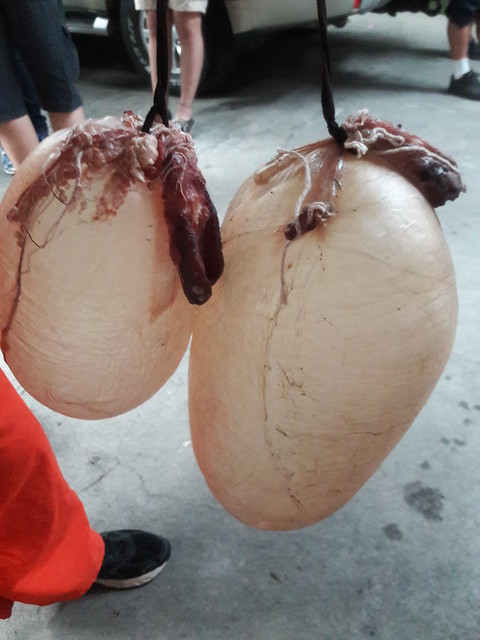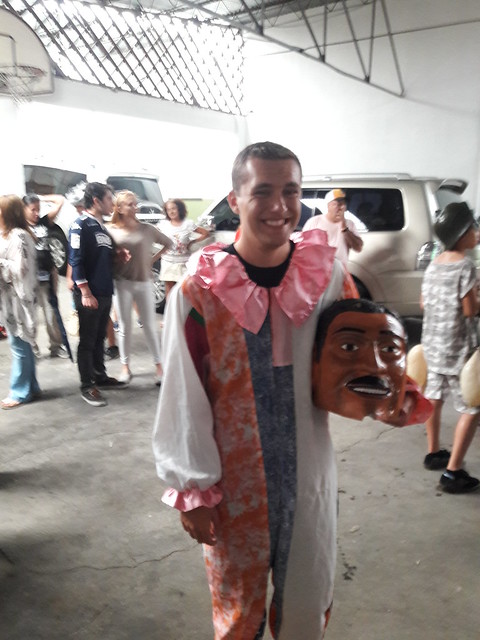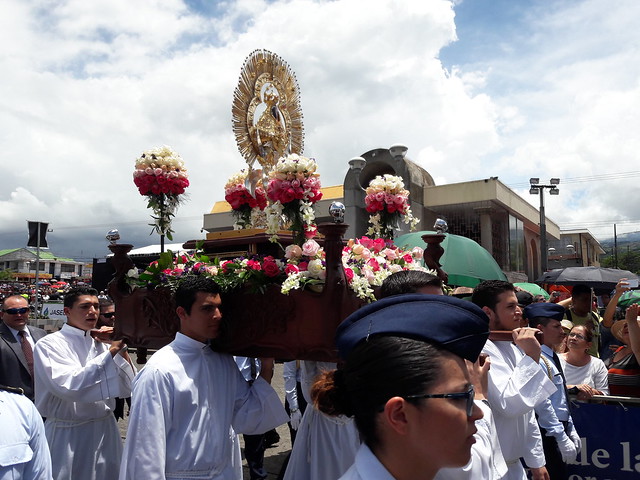Costa Rica: El día de la virgen de los ángeles, roosters, saints, clowns and… cow bladders?
By Garren W.
Sept. 21, 2017
When you hear of Costa Rica, you probably imagine beautiful beaches, tropical rainforests and tons of tourists. All of that is here (Costa Rica is a beautiful country), but you probably don’t think of what happens in the rainy season from roughly March to October. I’ve on an IFSA-Butler calendar year program here since February, and I can say that August has been by far the most culturally significant month so far, yet most people shy away from the torrential rains in the Central Valley and never get to witness what I have.
Saints, clowns and cow bladders
No one could imagine how these three things could possibly fit together unless they’ve visited the Fiestas de Barva. My host family has been living on the side of this volcano just North of Heredia for generations, and they all say that the event is unlike any other in the world. After seeing — and participating in — the festivities, I don’t think they could possibly be wrong.
Officially, the nearly month-long celebration honors the patron saint of the local church, San Bartolomé de Casas, a central figure in the history of the church and of the conquest of the new world for his role in restricting the Sistema de Encomienda. Unofficially, it’s a local cultural festival without peer.
On nearly a daily basis, the townspeople gather at a predetermined location at 2 in the afternoon and begin marching through the streets. They go dressed as clowns, monsters and giants; if it weren’t for the vejigas and the marching band, it could look like a traditional Halloween festival in the United States. Of course, the vejigas are a pretty stark contrast to the candy we would expect in the States. They are (mostly) dried cow (and sometimes pig) bladders inflated with a straw and tied to string and used to hit any exposed flesh of the innocent onlookers. While it may sound like a violent (which it sometimes is) and disgusting event from North American perspectives, Bárveños embrace it. Some young men even walk shirtless to attract the greatest number of hits they can, the welts on their backs shining in the afternoon rain.

After watching the event for a few weeks, I realized I would regret it if I didn’t participate at least once — it’s hard to say you lived in Barva if you’ve never been in the parade — and so I rented a costume from a local artisan. It started pouring rain at 2 p.m., and by the time the pre-parade celebrations had terminated, the streets were running with water. We walked four blocks to the first dedication (where a family had paid the event committee) and everyone stopped to dance for 20 minutes as the band played. After another few blocks, the parade passed my house and I decided that an hour was enough participation to have had the experience. The rest of the parade would continue in all its clown-filled and vejiga-swinging glory for another three hours, making it the fourth one of the day and the last of the year.
Virgins and roosters
Across Latin America, many countries and even local regions celebrate a virgin as their patroness. Each one is seen as a representation of the Virgin Mary within the Catholic Church, and each has a particular story to tell.
According to Costa Rican legend, a young free-woman of African descent found a small black statue of a woman with a swaddled baby in arm on a rock in the middle of the forest near Puebla de los Pardos (village of the free Black people) outside of Cartago, the colonial capital of Costa Rica. She carried the statue home with her and stored it within a box, but the next morning it was nowhere to be found. She returned to the rock in the forest to find the statue had miraculously returned. She attempted to carry it home again, only to find that the same thing had occurred by the next morning. She then took the local priest with her, and he took the statue and stored it within the church. When he found that it had even disappeared from there, he declared that it was a message from the Virgin Mary that she wanted to be there, on her rock in the forest. He began construction of a small temple over the site and the free-men and free-women slowly moved their settlement in that direction.

Today, this site is the center of Cartago and the church is the Basilica of Our Lady of the Angels. Traditionally, people from across the country complete the romeria, or pilgrimage, to the site on Aug. 2, the day that the statue was said to be found in 1635. Now, most people go early, with the majority walking the evening of the first and spending the night in the park in front of the church. The crowds are enormous, so the government closes the highways to and from the city and the Red Cross sets up aid stations along the way.
I chose to walk the morning of Aug. 2 with some members of my extended host family and their friends. We drove in to San Jose (cheating, I know) and walked the remaining 20 km along the side of the road. While the crowds weren’t quite as large at 6 a.m., it was still clear that a lot of people were making their way to the celebrations. We passed a lot of beautiful sites including small waterfalls and hilltop and mountainside views, but what really shocked me was the amount of support the community gave to the romeros (pilgrims) — everywhere I looked, there were aid stations or water hoses (tap water across the country is potable) or massage stations set up for us to use at no charge.

Around 7 a.m. the foot-traffic started to pick up as we got closer and more paths merged. It was around that time that a man passed by with a device that looked like a stroller, but rather than a baby, he was carrying a rooster the entire way to the basilica. I tried asking my host family about it, but they laughed and explained that it was better not to ask. When I pushed for more, they would only say that there are a lot of other faiths which have mixed with the Catholic heritage in the country and that many of the practices from these diverse cultures are now practiced as a part of the traditional Catholic celebrations. Unfortunately, I never got to see what became of the man and his rooster, but I did get to witness plenty of other things.
When we arrived at the plaza in front of the basilica, there were thousands of people gathered and the bishop was personally giving communion along the cordoned pathway while other officials gave speeches. After about 20 minutes, the religious procession started. First, singing students of theology passed by wearing the stoles of their respective orders, then the highest national and regional officials of the church, and then the alter with the statue itself as they entered the church. I was fortunate enough to have a front row place to view it all, but then I got even luckier when the event organizers allowed a small number of viewers to enter the church for the ceremony itself. The elite of the country were gathered within the church, singing and chanting their prayers, and I saw it all from a small gallery on the side.
El día de la virgen de los ángeles was a long but exciting day. I would recommend it to anyone looking for a more authentic view of the religious side of Costa Rican culture, assuming they are willing to brave the rainy season in the Central Valley.
About the blogger
Garren W. is studying abroad on the IFSA-Butler: Universidad Nacional program in Heredia, Costa Rica.